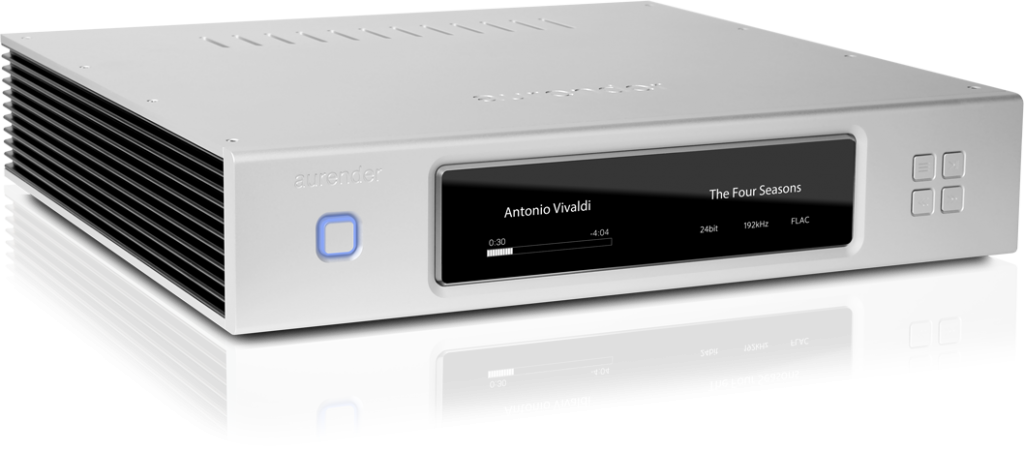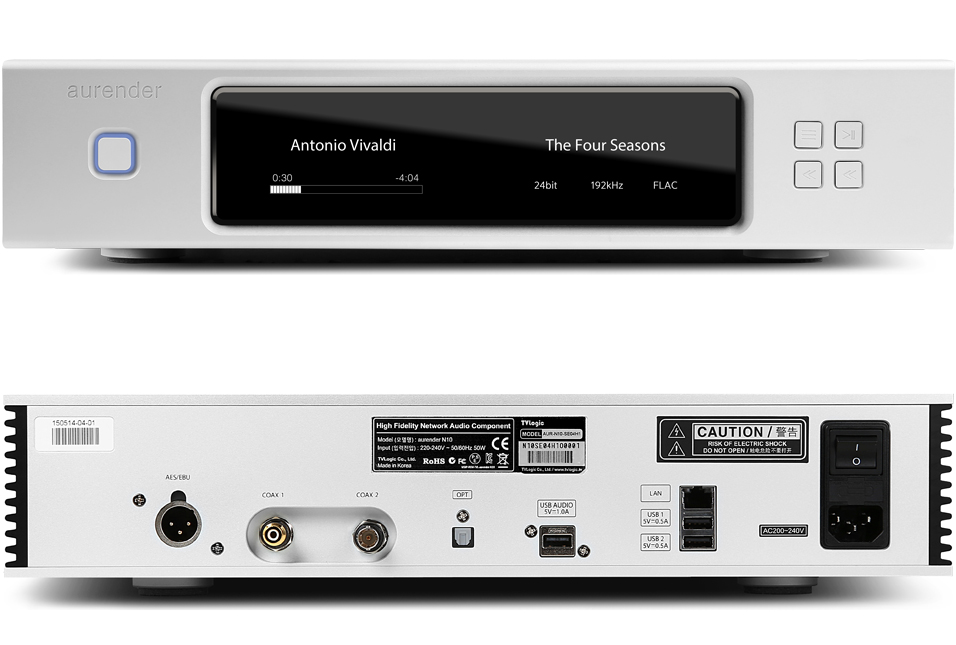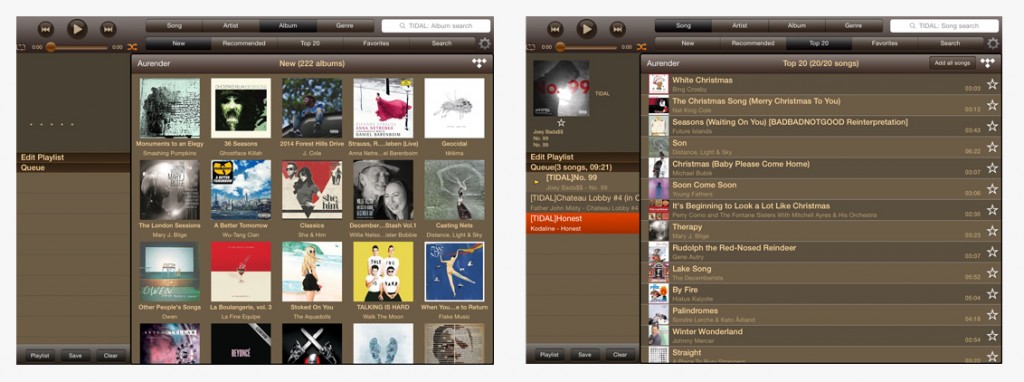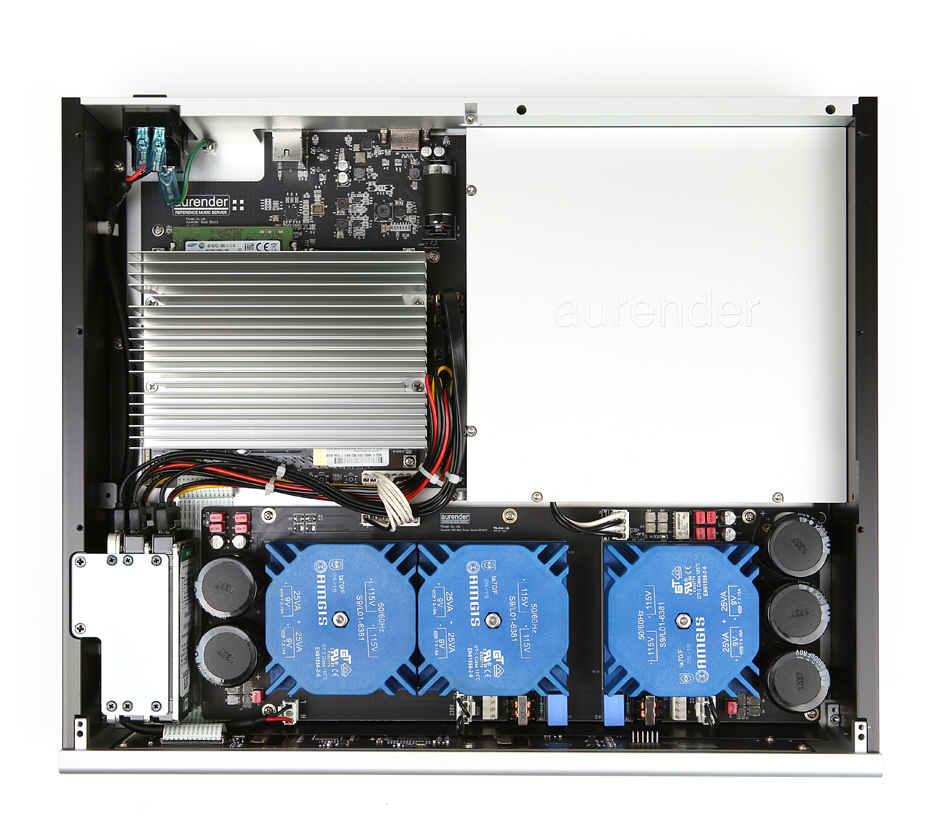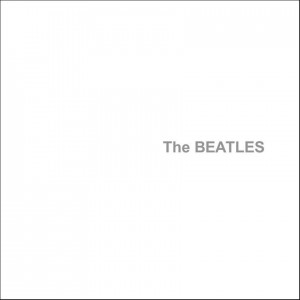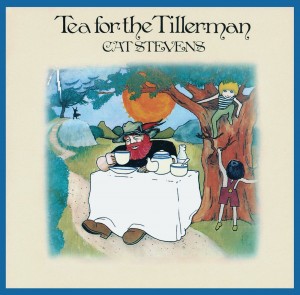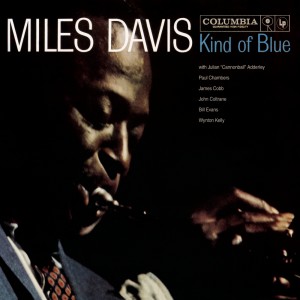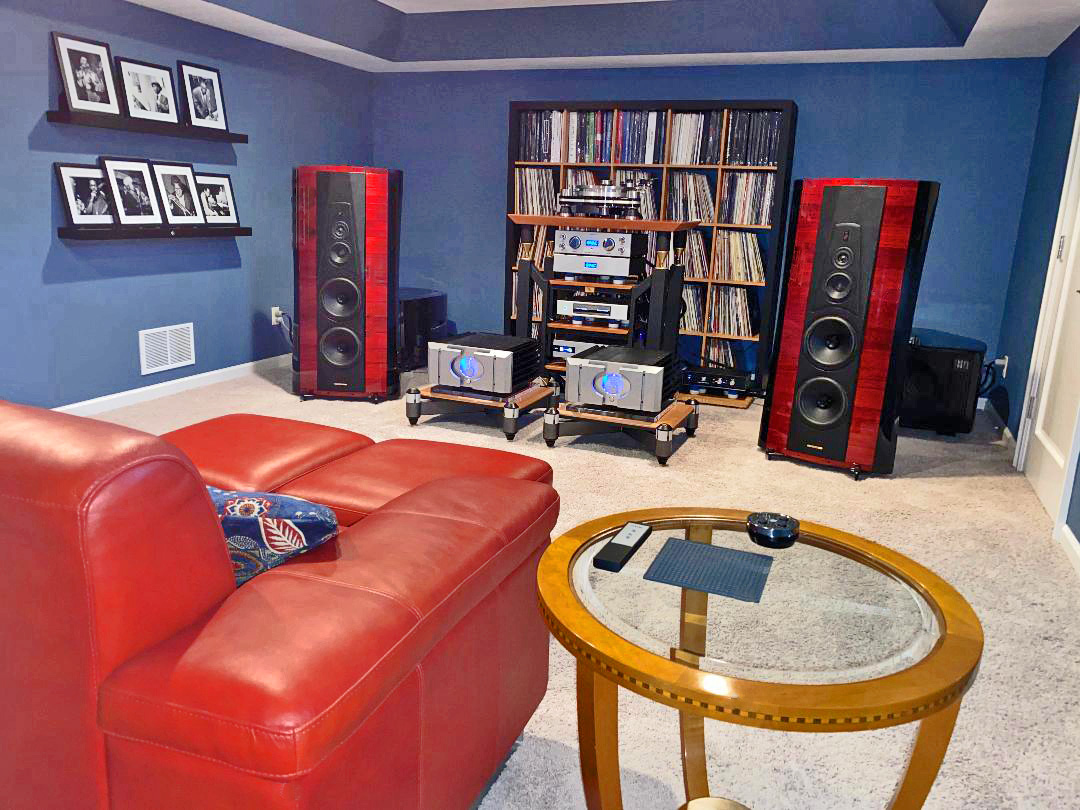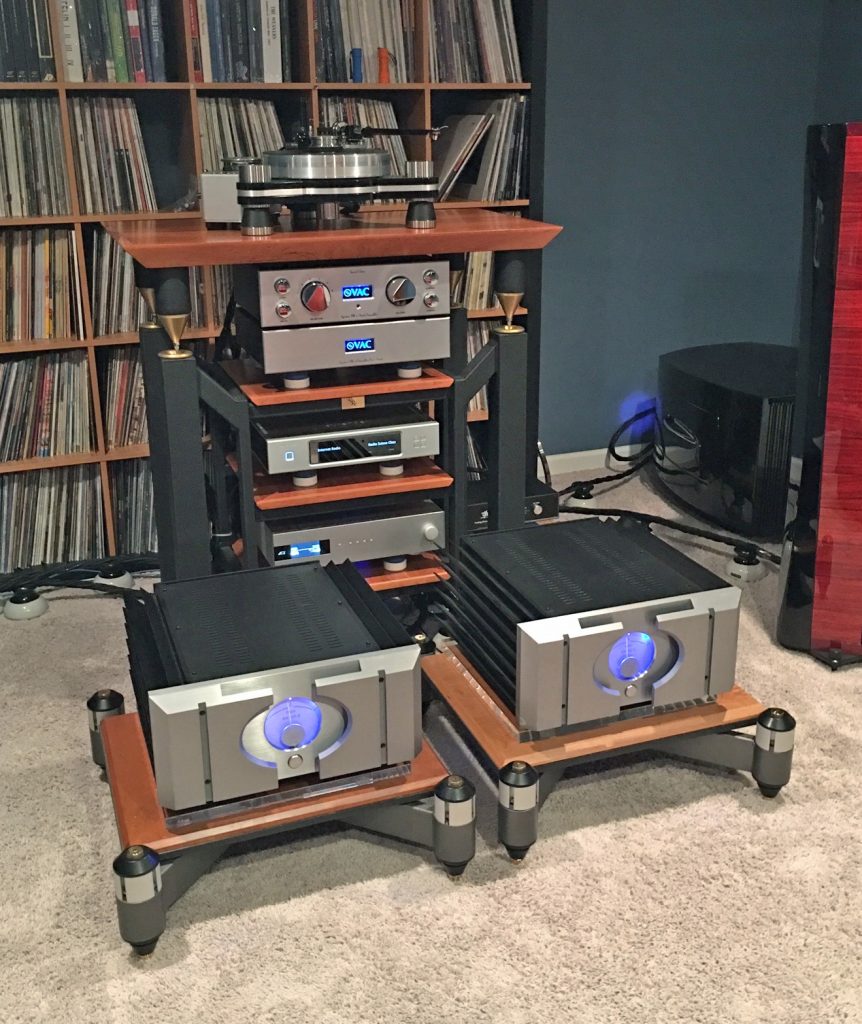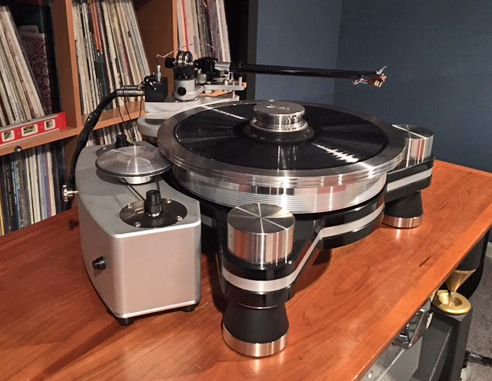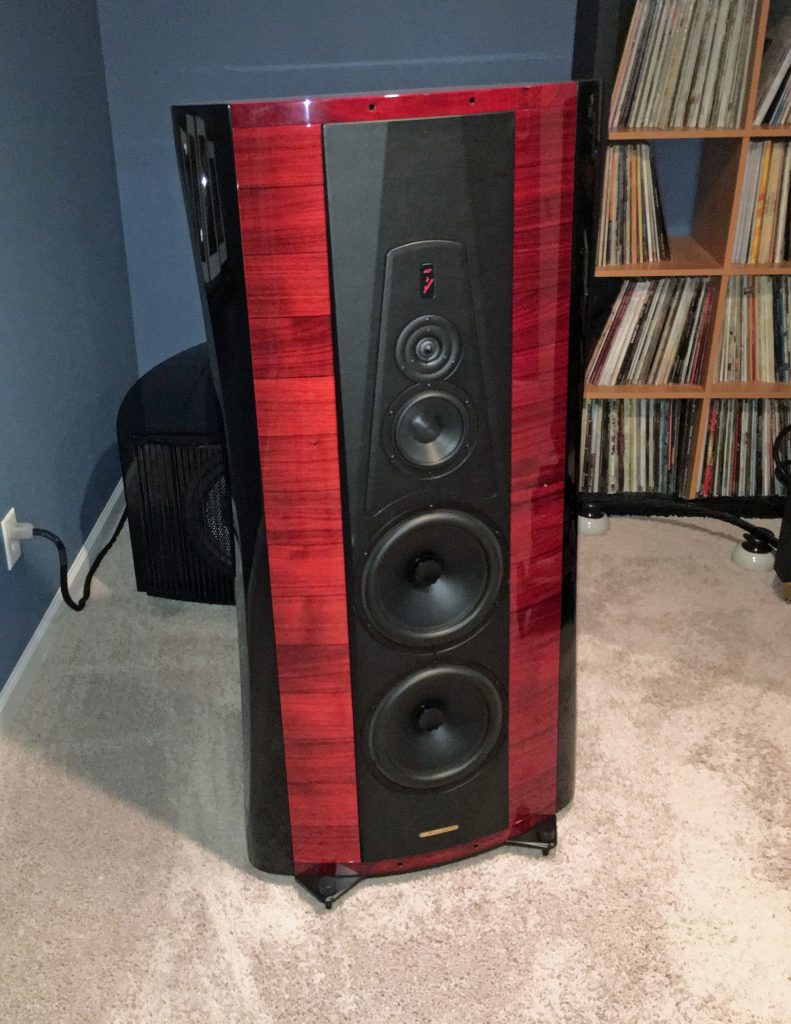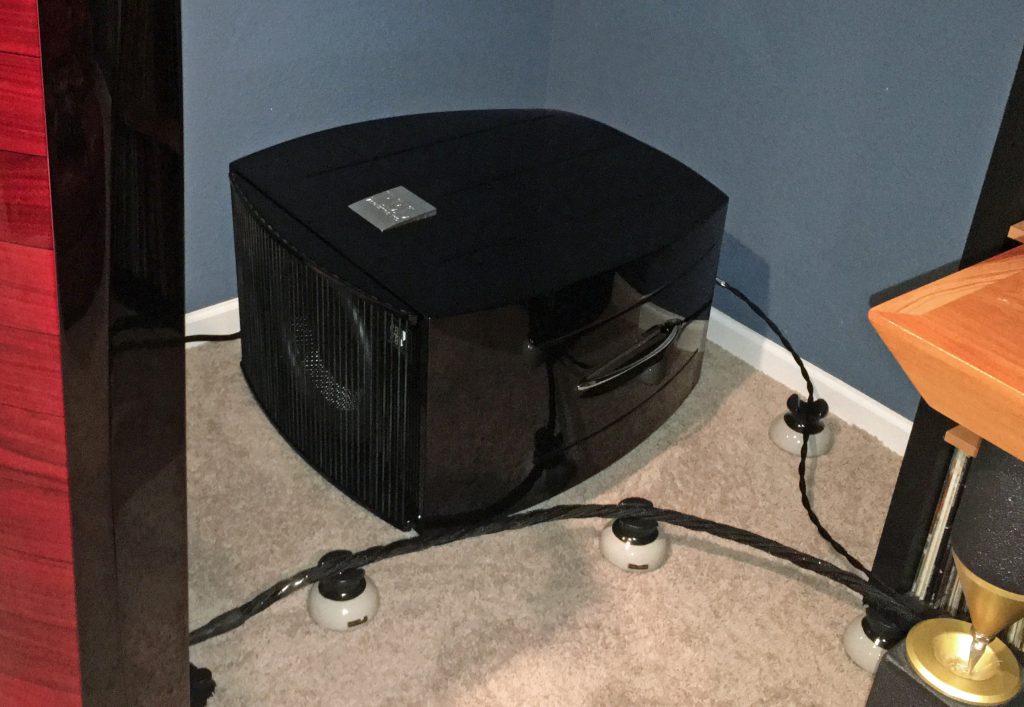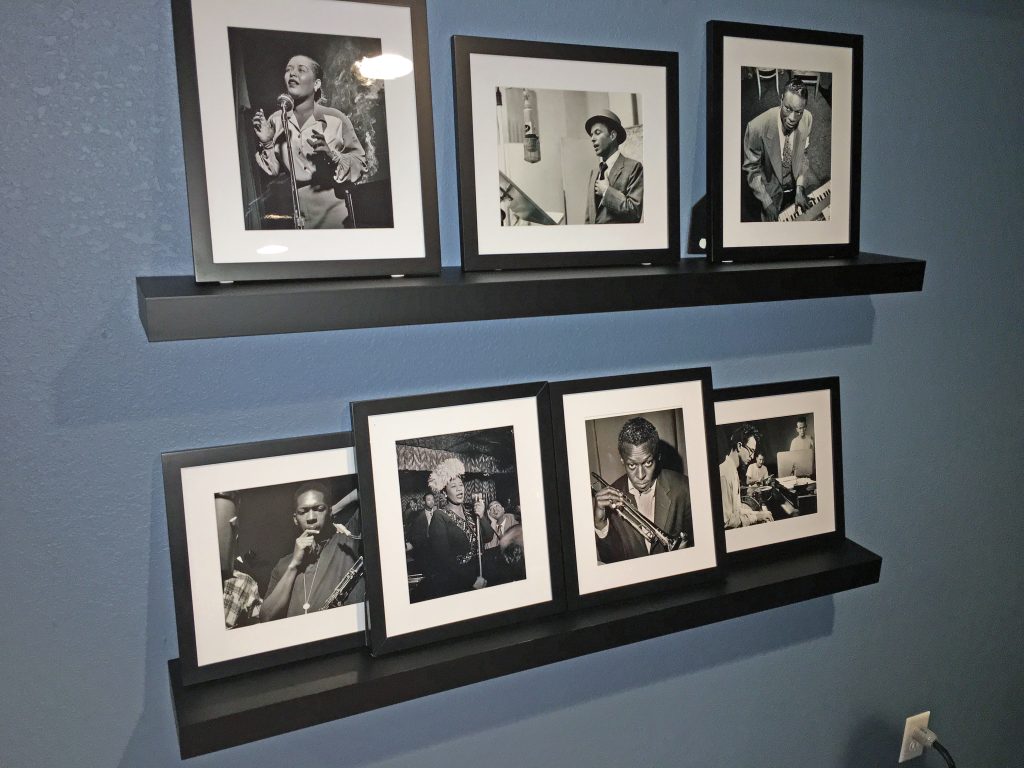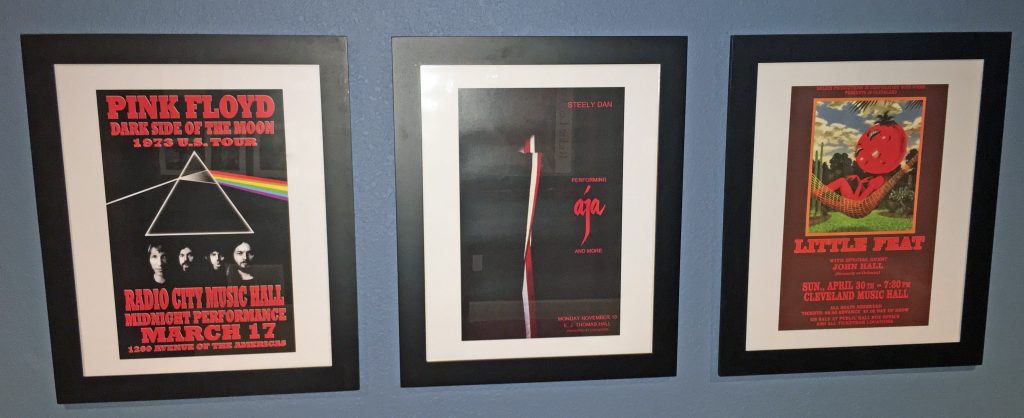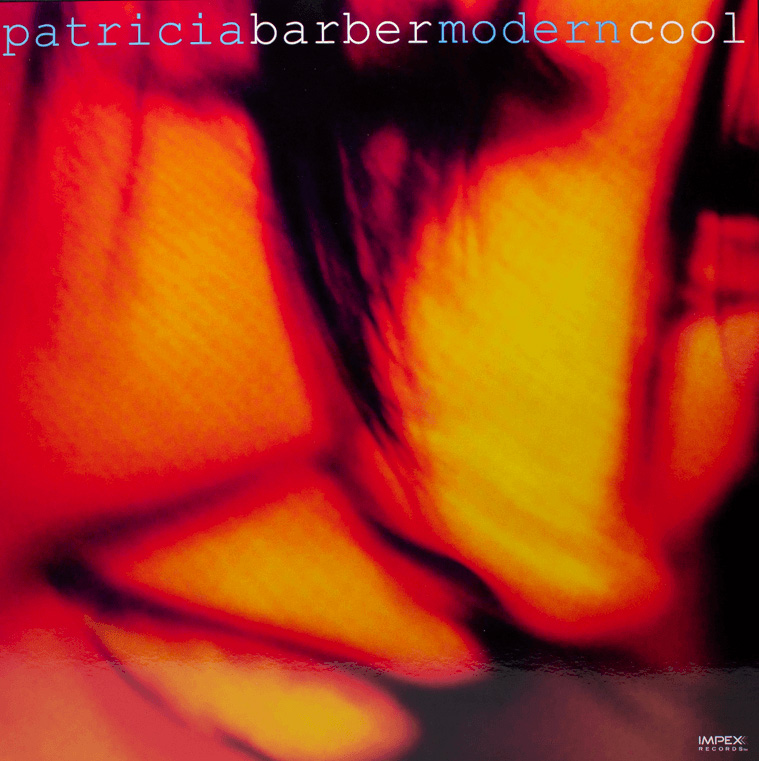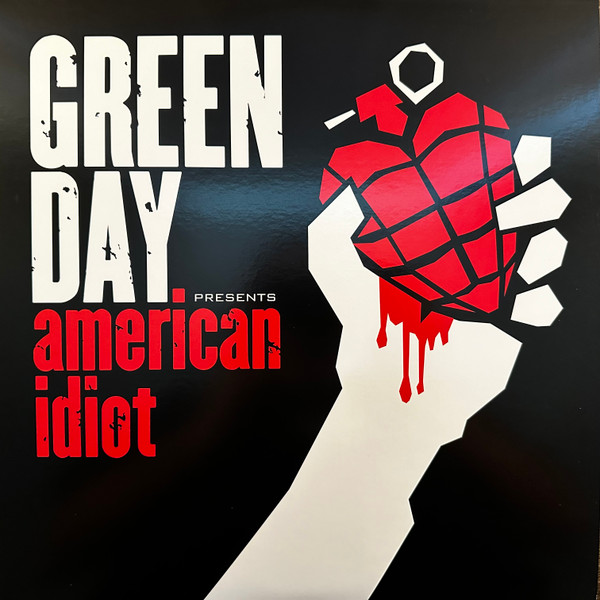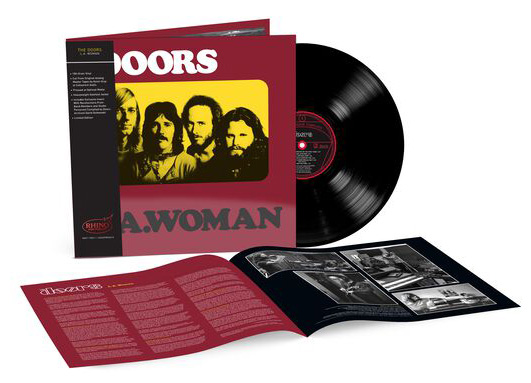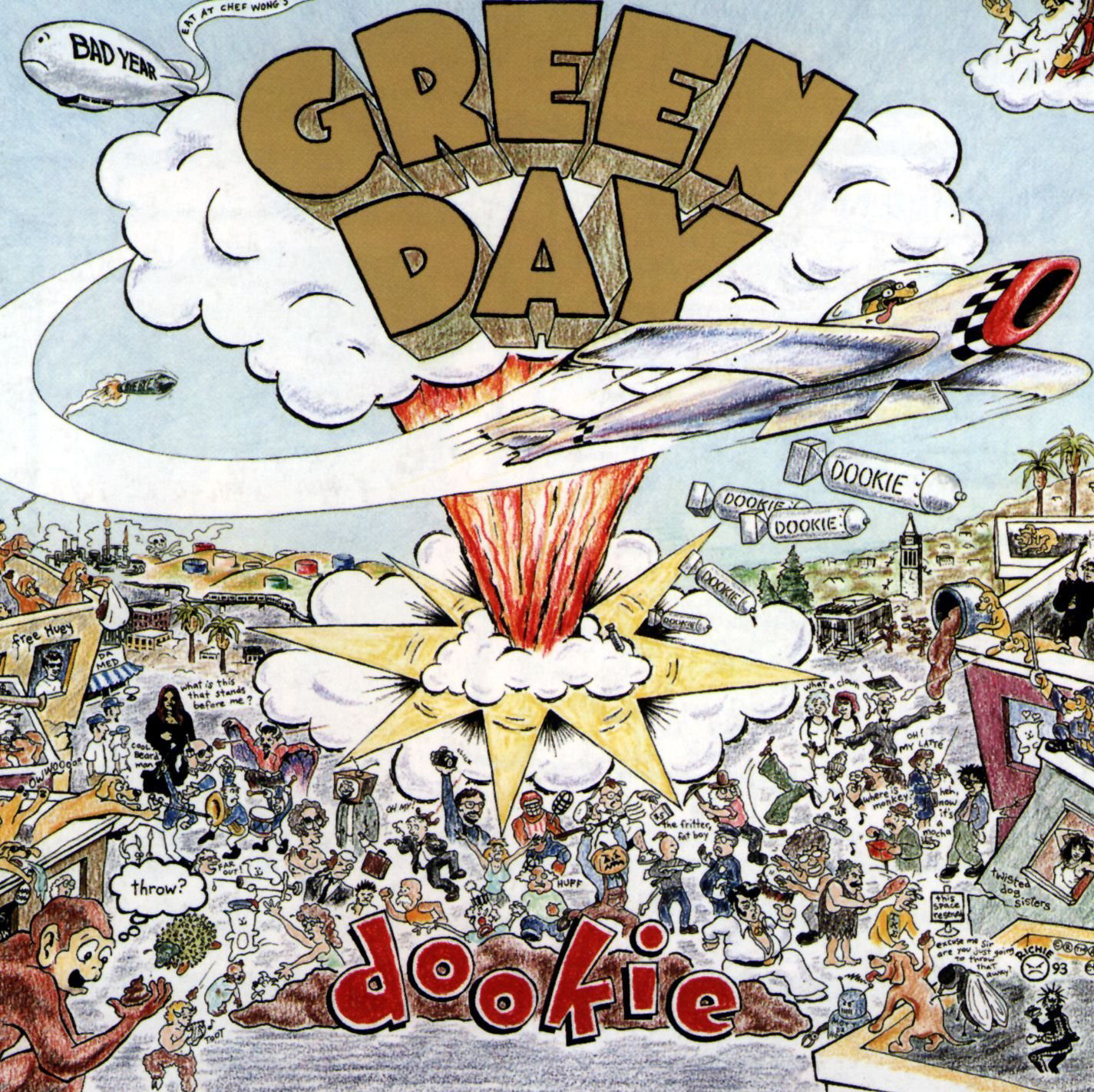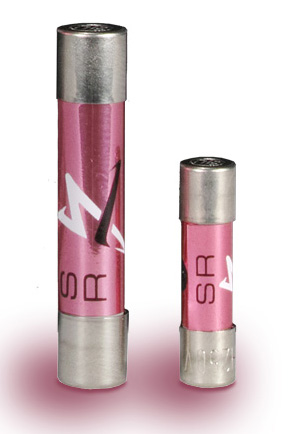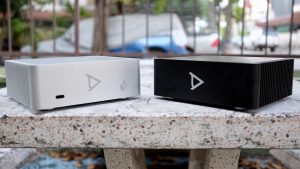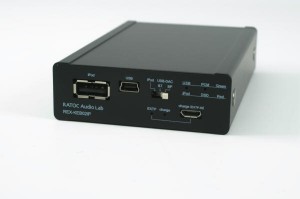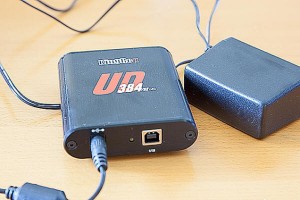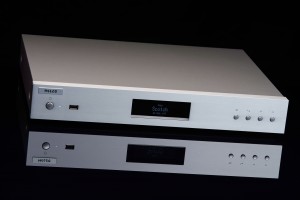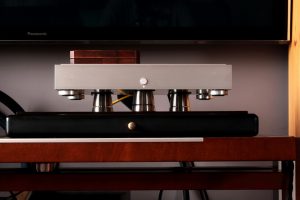My recent reviews for the Devialet 400 and 800 Integrated Amplifiers generated plenty of emails and comments. Thanks to all the readers who took notice and had an opinion to voice on these components—both yeah and nay. Just another example of different strokes for different folks. It was all respectfully done in good fun but also with some very passionate and articulate viewpoints. This subjective thing is what makes this hobby so rewarding and interesting.
One suggestion that came up several times was that I should strongly consider adding the Aurender N10 Music Server to the system and that I might be pleasantly surprised. Though the Devialet 400 and 800 are both hybrid Class A/D designs, this would make for a very simple three component system with a front end and amplifier that were primarily all digital. There is also some very definite synergy going on with both Devialet amplifiers and the Magico Q7 speakers—especially in the bass department.
The end result would be easy on the shelf space, wire, resonance control and in some cases the wife acceptance factor (WAF). Just my opinion, but these components are all beautifully designed from an aesthetic perspective and make for quite a combination. Even beyond that, some proclaimed that this system would absolutely kick butt and possibly cause many of our old school analog purists (like me) to hit the reset button. We shall see.
Primary Review System
- Devialet 800 Integrated Amplifier
- Magico Q7 Speakers
- REL Gibraltar G-2 Subwoofers
- Playback Designs MPS-5 CD/SACD/DAC
- Aurender N10 Music Server
- VPI Classic Signature Turntable
- VPI JMW 1-3-D Tonearm
- Dynavector DV XX-2 Mk II Moving Coil Cartridge
- Synergistic Research Element CTS Power Cords, Interconnects and Speaker Cables
- Synergistic Research Element CTS AES/EBU Digital Cable
- Synergistic Research Powercell 10 UEF and FEQ - Powercell Equalizer
- MIT SL-Matrix50 Interconnects and SL-Matrix90 Speaker Cables
- Rix Rax Hoodoo Component Rack
- Magico QPod Footers
Caveat Emptor
System synergy and personal taste are critical when evaluating high-end audio products. This review is based on my subjective requirements, my subjective ears, my specific system and my specific listening room. This combination is only one data point of many that exist out there for these components. Please consider my comments and analysis appropriately.
Design
From my perspective, the key philosophical and design advantages of a music server over an off the shelf computer is that a music server can be designed and configured specifically for audiophile needs and thus for better audio performance. With the most recent generation of music servers, many would argue that this now holds true even when compared to some of the very best hot-rodded Mac and PC configurations.
You can eliminate much of the hardware and software that is not only unnecessary but also might be impacting the sound with additional noise and performance issues. You can also focus your investment on appropriate hardware and software upgrades for the same reason. Compared to a computer, the designer has a completely different set of priorities for a specific configuration and price point.
For example, the mother board in the N10 is moderate in size and does not utilize traditional stock components. The N10 comes with 4TB of (2TBx2) hard disk drives and one 240GB solid-state drive cache for playback. The solid state cache helps to eliminate electrical noise and vibration that can impact sound performance. Dual linear power supplies and robust shielding are employed which many feel is more in line with today's audiophile design standards (though this commitment to linear power supplies might be evolving—see my comments in the Devialet 800 review on switched power supplies).
The N10 also provides a wide range of SPIDF digital outputs (AES/EBU, BNC, coaxial, optical) and one dedicated USB Class 2.0 output. For network connectivity, an Ethernet port and two USB 2.0 data ports are also included. An all Digital Phase-Locked Loop system (ADPLL) incorporating Field-Programmable Gate Arrays (FPGA) with OCXO clock technology minimizes jitter and maximizes transmission accuracy. Oven-Controlled Crystal Oscillators (OCXO) are among the most accurate and stable clocks available today. They are significantly more accurate and stable than the crystal oscillators found in most computers.
Compatible formats that are supported by the N10 include DSD (DSF, DFF), WAV, FLAC, AIFF, ALAC, M4A, APE and others. Bit and sample rates that are supported include the following. Please note that we don't have DSD256 (or Quad DSD) just yet on the N10.
- SPDIF: Up to 24-bit, 192kHz (PCM); 1-bit, 2.8MHz (DSD64)
- USB: 32-bit /384kHz, 1-bit, 2.8MHz (DSD64); 1-bit, 5.6MHz (DSD128)
The Aurender N-10 weighs in at approximately 27 lbs. with external dimensions of 16.93 inches x 3.27 inches x 13.9 inches. The front panel includes an AMOLED screen that can present either the current metadata in play or a simulated VU meter screen. Play, pause, forward and back keys are also provided on the front panel though your iPad and Conductor app will probably be your main vehicles of choice for these functions. All in all, a very impressive looking and feature packed offering at a MSRP of $7999.
Aurender Conductor App
The Aurender Conductor app is a superb example of how competitive the industry is and how quickly remote application control and related features have evolved. As a user interface, I feel strongly that the Conductor app is one of the best out there and has set a new standard for music servers. Currently available for iOS devices, plans are in place to support Android platforms in the near future. With the Devialet and Aurender applications at your finger tips, you will be hard pressed to ever leave your listening seat for either system functionality or music selection.
I greatly enjoyed the flexibility and ergonomics that the Conductor app provides. I am very much a visual guy. The system menus and format were easy to follow; simple logic carried the day. All options were easily accessed through the Settings menu. Compared to a typical computer, there were very few options to consider with no hidden "insider" tricks for better sound. The library can be browsed and searched by various tabs including Artist, Album, Composer, Genre, Song, etc. You can also set up filters to to sort by Genre, Favorites, and file resolution (DSD, PCM, etc.).
The entire "play" process was driven by generating a playlist which seemed very intuitive and easy to follow. For example, when friends came over to hear the N10 in my system, within seconds I could bring up a specific album or song request. While this was all in play, I was also able to generate a second playlist of specific tracks from several albums that I wanted to use to illustrate key points of performance criteria (i.e.- a demo playlist). All of this was from my listening position in real time. I never had to shuffle through a shelf of CDs and LPs to find what I was looking for. No interaction with a cumbersome laptop or computer. No wait beyond a few seconds on my part or for my friends. Yes, this is all obvious stuff that you have probably experienced before, but this music server thing is quite addictive.
Beyond the basic control functions, the Conductor app supports several very interesting features that helps to separate the N10 from the pack. Please see a short list below. An all inclusive list with additional descriptions and detail can be found on the Aurender website.
- The Aurender N10 has supported a DSD to PCM conversion option since it's introduction. A new feature entitled "On-the-fly DSD to PCM Conversion" will allow you to compare DSD to PCM performance for the same music file in real time (a very hot topic these days).
- Aurender Media Manager (AMM) will combine music stored on external NAS devices with that on the Aurender so that you can have a unified music database regardless of file location and without performance degradation. Via the Conductor app, you can view all music files and metadata as if it was all stored internally on the Aurender.
- "Smart Copy" allows you to copy files from your NAS or USB storage to the Aurender by utilizing the Conductor app. A computer is not required to manage these file transactions.
- "Remote Internet Support" can be requested by engaging the help option on the Conductor app. This support request allows Aurender engineers to quickly diagnose and fix problems over the Internet.
- Music streaming for both Tidal and Qobuz is supported and can be managed directly from the Conductor app. Qobuz is available via Aurender components in those countries where the Qobuz service is available.
Sound
I copied several dozen files from my QNAP NAS and WD hard drives to the N-10. This included 16-bit/44.1 kHz, 24-bit/44.1kHz, 24-bit/96kHz, and 24-bit/192kHz PCM files. I also copied over DSD64 and DSD128 files. I know that many feel that some music servers and DACs can sound better for DSD and some better for PCM. I am not gonna get into a DSD verses PCM comparison here.
All I can say is that both formats sounded absolutely wonderful through the N10. Unlike several contenders, the Aurender N10 seems to shine for virtually any format. Yes, production values are probably the most important thing for most recordings, and just like CDs and LPs there are good and bad high resolution files, but the better DSD128 and 24-bit/192kHz releases both had my hair standing on end.
For this review, I had plenty of fun checking out the N10 with three different systems. In retrospect, I think that it says something important that the N10 was a successful if not outstanding match for all three. It's pretty much a neutral component but if I was forced to point to one side of the fence, I would say that it provides just a slight bit of weight and texture to the system compared to other digital front ends. This is all good by me as a little extra weight and texture is almost always very appealing when it comes to digital.
System A – Devialet and Magico
I used the Aurender N10 in my own listening room connected directly to the Devialet 800 integrated amp via an AES/EBU cable for best results. I also tried a USB cable, but it did not quite measure up—slightly compressed and and almost clinical in character. This did not surprise me as Devialet recommends an AES/USB interface for best results. For comparison purposes, I also used an AES/EBU cable from my Playback Designs MPS-5 CD/SACD/DAC to the Devialet 800.
Please note that these were all digital outputs from the N10 and MPS-5 and of course all digital inputs to the Devialet 800. No analog to digital conversion between components. Wire was primarily Synergistic Research Element CTS.
For my own system, it was the first time that 16-bit/44.1kHz files from a music server/DAC or computer/DAC combination could compare favorably with the MPS-5 for CD quality playback. For other combinations, there was always something not quite right whether it be pace, rhythm and timing (PRAT), or transparency. In this case, the N10 and Devialet combination was quite remarkable.
For DSD and higher resolution PCM files, the N10 was a true revelation. Dare I say that it greatly reminded me of analog. There was a certain organic sense of air and harmonic texture to the sound that had me sitting from beginning to end for each album—very rare for me when it comes to digital. The true nature of the Devialet 800 integrated amp and Magico Q7 speakers was still all there but greatly enhanced. Fast, fast and more fast with just the right amount of inner density and slam yet now even a more realistic purity and refinement.
System B – Pass Labs and Sonus Faber
I am not a big fan of the analog inputs on the Class A/D Devialet 800. I prefer using the digital inputs when possible. The additional analog to digital conversions seem to slightly impact the sound. For this reason, I took the N10 and my Playback Designs MPS-5 CD/SACD/DAC over to a friend's listening room for a different type of comparison.
This system has a slightly warm flavor and consists of the Pass Labs XP-20 Preamp, Pass Labs XA200.5 mono block amplifiers and Sonus Faber Stradivari speakers. We listened to CDs and SACDs directly from the MPS-5. We listened to music files loaded on the N10 connected to the MPS-5 as a DAC. In this system, the signal stays all analog from the MPS-5 analog outputs and through the preamp and amp—a more typical analog hand off. Synergistic Research Element CTS wire was again used throughout.
It important to note that I am very familiar with this system. I have spent several long listening sessions over the past twelve months checking out the sound and the impact of other components. The Pass Labs and Sonus Faber Stradivari combination was immediately taken to a new level of performance. My buddy was asking me for the list price on the N10 within 30 seconds of the first track. In this system, both the AES/EBU and USB connections were equally superb for 16-bit/44.1kHz files. I could not clearly identify a difference between the two interfaces.
If you are familiar with the MPS-5, an external USB interface is provided by Playback Systems and is required for DSD and high resolution PCM files. On the better produced high resolution files, I heard details that I have never heard before. The genuine warmth and seductive sound of the Pass Labs and Strads was still all there in spades, but there was a definite improvement in resolution and extension at both ends. Mids were fleshed out and layered like never before. Nothing was tipped up or falsely enhanced. All was "au naturel'. Again, we could have easily mistaken the source as analog.
System C – Audio Research and Vandersteen
Lastly, I spent some time with Jonathan Spelt of Ultra Fidelis Audio in Wauwatosa WI. His personal listening room and system were an absolute delight (please see my comments below about Jonathan and the role of Dealers in our industry). We used the N10 connected via an AES/EBU cable to an Audio Research DAC8. The rest of the system consisted of the new Audio Research 6 preamp, an Audio Research 75se stereo amp, Vandersteen 3A Signature speakers, and two Vandersteen 2Wq subwoofers. Audioquest DBS wire was used throughout.
I only spent one afternoon with this system, but I was mightily impressed. These Audio Research components are known to have many of the best attributes of both solid-state and tubes, but that wonderful midrange bloom and immediacy is the real highlight. There is a reason why the Vandersteen 3A speakers continue to be one of the biggest sellers in the industry.
The N10/DAC8 combo immediately set me at ease like a nice glass of Chateau Potelle Cabernet Sauvignon. The sound was wonderfully fleshed out and clearly delineated. There was an effortless level of speed and lifelike harmonics to everything that I heard. Micro and macro harmonics could compare with the very best. I was especially impressed with the tremendous depth and breadth of the soundstage on the toughest recordings.
I asked Jonathan if he still felt a need to listen to his LPs. He gave me a sacrilegious look of despair, but quickly answered that there were definite occasions for both. To my ears, the N10 was now providing an interesting alternative source for even the most discerning music lovers.
Music
Beatles - White Album (PCM 24bit/44.1kHz)
Produced by the late George Martin, recorded at EMI Studios, and released in 1968, the White Album is my favorite Beatles album. Like the infamous line in the movie Men in Black, it seems that despite the ever evolving format of choice, we will continue to seek out and pay for what ever the latest technology can offer for this release. It's that good. We always want more. We always want to squeeze out every last little bit of joy that we can.
I have the original US Apple LP release, the MFSL LP box set, the original 1987 Apple CDs and even the 2009 Apple stereo and mono reissues on CD and LP. I have long given up on them all preferring my complete set of original British Parlophone stereo LP releases. All of the former can be edgy and over the top—especially the CDs. Like my friend the Baby Bear, the Parlophones sound just right. There is no comparison. Until now.
The 2009 PCM 24-bit/44.1kHz White Album reissue on memory stick and downloaded to the N10 has me re-evaluating my rankings. The N10 had me thinking analog again. Even my wife sat up tall and strong when I switched back and forth between the 2009 stereo CD release and this PCM file. After my second flip back to the N10, I got a stern look and was told to put down the iPad. What can I say? She has excellent ears!
Written by John Lennon, the song Dear Prudence is an excellent example of the clear difference that I was hearing. The subject of the song is Prudence Farrow, a sister of actress Mia Farrow, who tagged along when the Beatles went to India to study with the Maharishi Mahesh Yogi. Supposedly, Paul and John were trying to draw Prudence out of her timid and bashful ways.
The guitar work by both Lennon and Harrison is now unleashed from the mix and vividly floats between the speakers. McCartney's effort on drums is astonishing considering that Ringo had just temporally left the Beatles in a huff (and soon to return). The handclapping, cowbell and tambourine added in post production by Harrison and McCartney now seem to jump from the soundstage.
Lennon's voice-overs are far more layered and defined than I recall on any other format. The icing on the cake for me are the added bass overdubs by McCartney which are deeper and more physically startling then ever before. With the Aurender N10 providing the source file, you will definitely be Back in the USSR and soaring like Lucy In The Sky Of Diamonds.
Cat Stevens - Tea For The Tillerman (Single DSD 2.8MHz/64fs)
For me, Tea for the Tillerman is one of those old school albums that continues to hold up over time despite my commitment to the aging process and my ever expanding musical tastes. Even my kids acknowledge that this is a special album that transcends several generations. This is Cat Steven's fourth studio album and was released in 1970 on the A&M Records label in North American and Island Records in Europe. For the first time, he had a hit record in several top ten lists and it eventually carried him to International stardom. Along with the follow-up Teaser And The Firecat in 1971, these two albums are considered absolute classics and possibly the greatest one two punch ever for one Pop/Rock artist.
Many folks tend to lump Cat Stevens into a "folksy" category along with the likes of James Taylor, Jim Croce, and Dan Folgelberg from the 1970s. I feel like this is a mischaracterization and his music and style can be much edgier and more emotional than these artists. His lyrics were both thought-provoking and memorable despite his many hits and airplay. As a young man in my teens, his insightful tales on the trials and tribulations of youth hit very close to home and generated plenty of discussion in my inner circle of friends.
From a production standpoint, Tea For The Tillerman was a fairly simple effort that includes acoustic guitar, bass, keyboards and drums. On occasion, there is an interesting string arrangement thrown in but nothing too fancy. This makes for a simple recording process and probably explains the excellent sound that is realized. In the early days of high end audio, you could not find an audio salon that did not have Tea For The Tillerman and/or Teaser And The Firecat in their demo bin.
As with all things audiophile, Tea For The Tillerman was reissued many times and in many formats. The ultimate LP pressing is the very limited edition (5000 units) Mobile Fidelity Ultra High Quality Record (UHQR) release. Folks, I never owned this version as I could not afford the asking price (currently around $1000 in mint condition), but I did hear it at a CES show in the 1990s. Sublime. Otherwise, the original Island Record pressing from Europe is typically considered the best.
No need to be picky here though. IMHO almost any pressing from the 70s in good condition will be quite enjoyable and will put your system to a good test. On the other hand, I have found the original 1984 CD, the Deluxe Edition CD in 2000 and even the Mobile Fidelity CD from 1988 almost unlistenable. It varies from reissue to reissue, but most have a bright top end and severe muddiness in the mids and bass. I have grown to enjoy the 2014 SACD from Acoustic Sounds, but none of these digital offerings can hold a candle to vinyl.
The Single DSD download from Acoustic Sounds is a different animal. For the first time with digital, I can sit through this entire album and forget about the sound yet still be transfixed by the music. No, it ain't Double or Quad DSD (I understand that a Double DSD of the album is now available), but it gives me hope that even Single DSD has something quite good to offer. Acoustic Sounds now has hundreds of Single DSD reissues on it's website. We will just have to wait and see what the troops have to say.
Via the Aurender N10 driving either the Devialet 800 or MPS-5, the track Father and Son will make your system sing. Simply and closely miked, Cat Steven's voice will enchant you with all the rich sonic texture and pin point imaging that you could want. As with an LP, you can clearly hear that he sings in a deeper register for the father's lines and higher for those of his son. For once, his guitar stands out in space with an appropriate amount of warmth and harmonics—not that glassy edgy feel of the CDs.
As the band and his vocals reach a crescendo late in the song, we have an inviting sense of excitement even though there is a bunch going on simultaneously. This can cause distortion and somewhat of a smeared sound with hay dayother digital front ends. The N10 sorts it all out beautifully without any loss of dynamics and articulation. Yusuf İslam would be proud.
Miles Davis – Kind of Blue (PCM 24bit/192kHz)
Hope I am not boring you with all of these well known standard recordings. Kind of Blue is another audiophile favorite that has been reissued on virtually every format known to man. For that reason, it is probably very relevant here as most of us have heard it in one format or another and can probably relate to my findings.
We all know the story. Miles was in his heyday at the time. Released in 1959 on the Columbia Records label, the sessions featured what might possibly be his most talented group of supporting musicians. This includes Bill Evans on piano, Jimmy Cobb on drums, Paul Chambers on bass, and Johns Coltrane and Julian "Cannonball" Adderley on saxophone.
Kind of Blue is based primarily on a musical technique called modality which uniquely focuses on scale and pitch. This was in contrast to most of Mile's earlier work that emphasized the hard bop style of jazz. Kind of Blue is considered by many jazz critics as his best album and possibly the most definitive recording of the jazz era. It is also his most popular having reached quadruple platinum status by the Recording Industry Association of America (RIAA).
Kind of Blue was introduced to me by my Father when I was a young teenager and just learning the ropes about music and music reproduction. It has always been considered a classic for both sound and performance. This is another recording that I have heard on the original US pressing and various reissues including vinyl, CD and SACD. This also includes versions from US, European and Japanese sources. I "get" all the adulation for performance. Miles and crew are in a zone and its hard not to just sit back and float along with the rhythmic vitality and emotion that they deliver. However, I never did understand all the hyperbole about sound.
Yes, this is a nice recording with plenty of sonic beauty and clarity, but even with the very best systems, I was never drawn into the music and soundstage. Regardless of the format, it just seemed to be missing the proper muscle on the low end and the inner detail in the mids and highs. This all changed with the Classic Records (1999) and Mobile Fidelity (2015) 45 RPM LP releases which were a real game changer. Now having experienced the PCM 24-bit/192kHz reissue through the Aurender N10, we have a digital bench mark that can stand up to the very best in analog.
For example, on the first track So What, we can finally hear the weight and texture of piano and acoustic bass as Bill Evans and Paul Chambers lead us into the composition. In the past, it seemed like I had to strain and turn up the volume to get any sense of the real thing. No longer. When Miles suddenly enters the soundstage, you will jump out of your seat as the punch and blatt of his trumpet easily shines through and startles you. Yes, there is a slight edge to that trumpet, but it feels very natural and real unlike other digital formats. The saxophone solo comes mid stream and winds its way through the rest of the players in a very calm but authoritative way. For once, you can hear the breathing and reediness of Coltrane's efforts and it will make you smile and take notice. Its all there now. And... it's all digital. Surprising but exhilarating.
Final Thoughts
If you are like me, computer audio has been a somewhat daunting experience. I have watched friends spend hour after hour (if not day after day) of frustration and anger trying to take this next step with their audio system. I have patiently waited several years until the hardware and software seemed stable. More importantly, I have waited until something approaching a "turn key" installation and setup was available to the uninitiated like me.
Even beyond all of this, I was seeking a comprehensive solution that could approach the best of analog in terms of sound and the best of digital in terms of ergonomics and user interface. If I was going to make another significant investment in my system, I needed to feel a connection to the music and not just be impressed by an audiophile checklist. The technology has finally arrived. The execution has been realized. The support is in place. The Aurender N10 has delivered on all of this and more. I think that music servers are here to stay and Aurender is one of the elite paving the way. Highly recommended!
The Dealers Role
Lastly, I have to give a big shout out to Jonathan Spelt of Ultra Fidelis Audio in Wauwatosa Wisconsin. "Tosa" as the locals call it, is a western suburb of Milwaukee. Aurender provided me with a couple of corporate engineering contacts for technical support and questions, but it was not necessary. For this review, I insisted on utilizing a local dealer and I was not disappointed. I wanted to give the entire process some credibility for our readers.
Let me get up on my soap box for just a few paragraphs. The dealer's role in high end audio is never given the credit and respect that is deserved. They are critical to the survival of this industry and this was just another example. I have said it before. You can buy through the Internet, but are you really saving money? In the end, a good dealer with years of experience can help you avoid poor choices, endless swapping, and much frustration. Component selection for ultimate synergy is both science and art. I have found that proper speaker setup can be a revelation in the right hands. Now we have computer audio which has been quite a challenge for most audiophiles.
Jonathan was extremely knowledgeable and patient. It was clear from the get go that computer audio was just another tool in his bag. He knows his stuff. You can always tell when you are lucky enough to connect with one of the good guys—they are always great listeners. We reviewed my current system and my music priorities. Once he had a firm handle on my specific needs, we were ready to rock. The whole process felt like a nice chat at the local bar or eatery.
Jonathan had a well organized tutorial ready and waiting to go on that first visit. It took only an hour to review system connectivity and the Navigator app set up. Though he provided guidance, it was strictly a hands on exercise for me which made it fairly simple once I got home. And once completed, we sat down and listened to music. This was some open your eyes and blink twice incredible music! I must also say that this man has excellent ears. If you ever have a chance to visit, check out his 24-bit/192kHz vinyl rip of a rare Japanese stereo pressing of Monk's Music by Thelonious Monk.
One more interesting tidbit that might be useful to our readers. Jonathan has some very insightful theories about the audio performance of wireless verses hard wired connections in your home network. In practice, his tips were quite beneficial when connecting the Aurender N10 to my system. In my case we used a very inexpensive wireless network extension device for my Ethernet connections. Others have used various upgrades in network wire and router technology. Just another perk of building a strong relationship and working closely with a local Dealer. Please see the link below:
http://ultrafi.com/a-little-side-trip-into-esoterica
Aurender N10 Music Server
MSRP $7999.00
Aurender America Inc.
2519 W. Woodland Dr.
Anaheim, CA 92801




